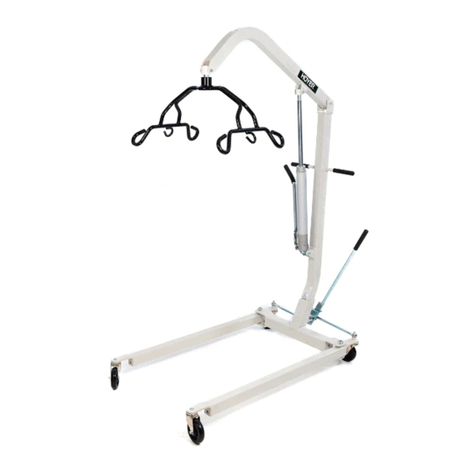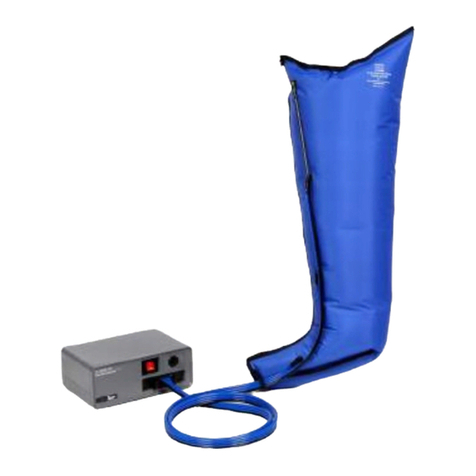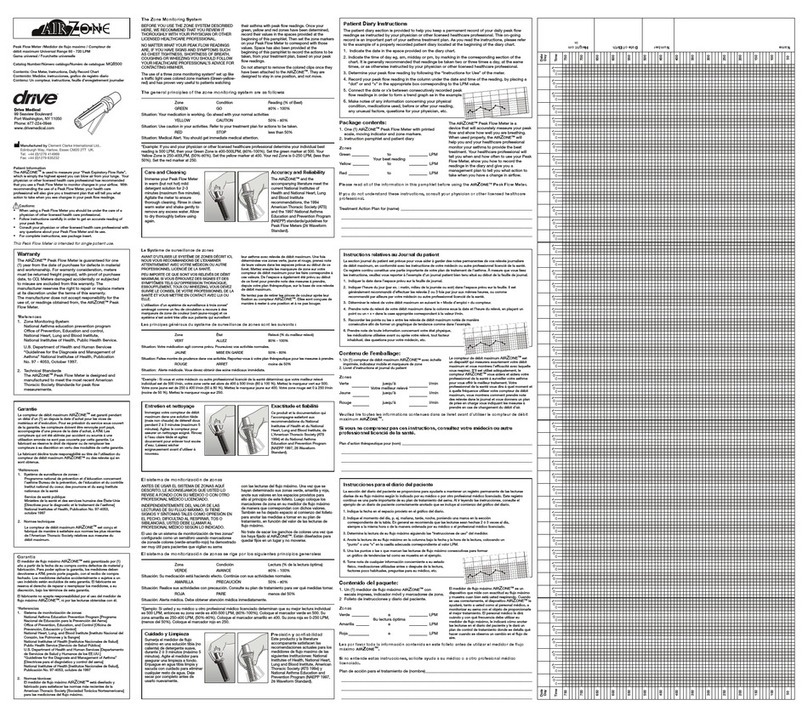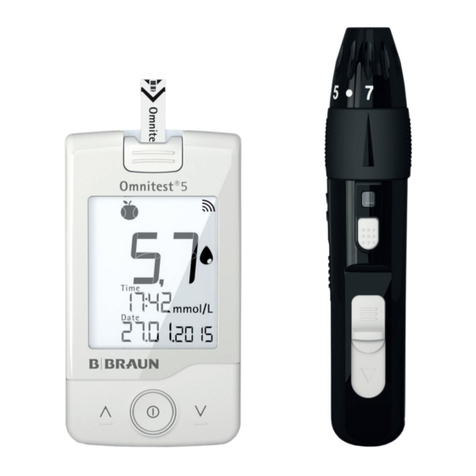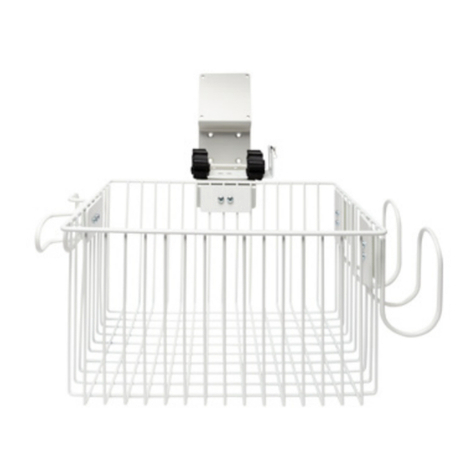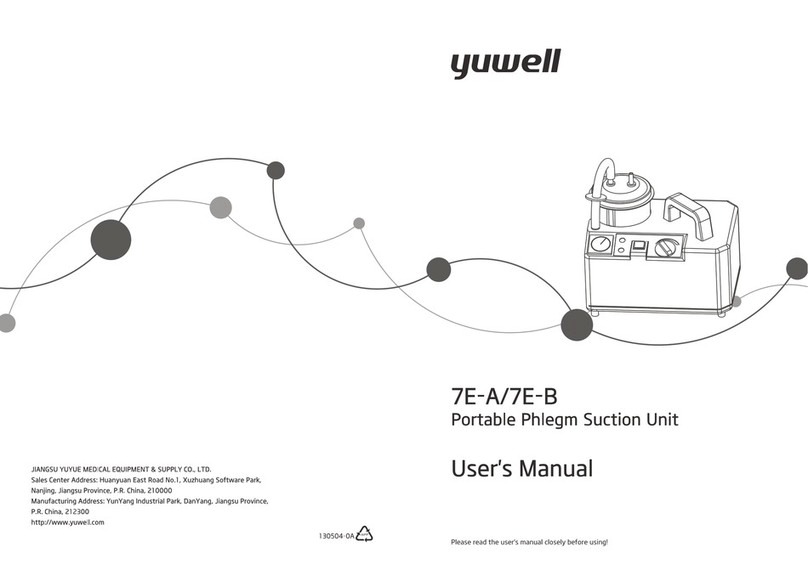Grainger 4802 Service manual

SCALE-TRONIX
4802
PEDIATRIC SCALE
SECOND GENERATION WEIGHING SYSTEM
OPERATING AND SERVICE MANUAL
(SERIAL NUMBERS 21000 AND UP)
NOW WITH DISPOSABLE DURACELL BATTERIES
ECO-FRIENDLY DESIGN

SPECIFICATIONS: 4802-PEDIATRIC SCALE
GENERAL
SCALE-TRONIX® 4802 DIGITAL PEDIATRIC
SCALE: Completely self-contained scale; accurately
weighs infants and toddlers.
The scale is contained in a portable, heavy-duty
stainless steel enclosure, with integral electronic
digital readout and a sturdy transparent acrylic
weighing cradle with length gauge. The patient’s
weight is automatically locked-in and displayed
during the weighing process, and simultaneously
stored within the scale’s memory for later recall. This
feature allows the infant to be removed from the scale
prior to charting the weight. A sealed membrane
pushbutton assembly provides the operator with a
choice of pounds/ounces or kilograms for the weight
display. Other front panel pushbuttons provide
on/off/zero, reweigh and recall of the previous
patient’s weight.
The scale can be operated directly from AC line
power, or when portability is desired, from internal
batteries. Features include automatic shut-off when
operating from battery to conserve battery life;
continuous operation when powered from AC line;
and automatic switching from batteries to line power.
Sturdy handles provide for easy transport and cradle
protection.
WEIGHT DISPLAY
Large, bright, 0.43” light-emitting diode display.
Easily read in all lighting conditions. Selectable
weight display in grams, kilograms, pounds, ounces
or pounds/ounces. Weight units can be restricted
and locked out by hospital. Indicator light to show
selected units. Previous weight held in memory for
later recall.
WEIGHING CAPACITY
10-20,000 GRAMS (20KG), 44 lbs.
ACCURACY
5 grams
OPTIONS
Diaper option provides 1 gram resolution for weights
less than 1 KG.
Manual part No. 070060 (G), revised July 2014.
UNIVERSAL POWER SUPPLY
Medical grade UL listed external power supply.
100-240 VAC 50/60 Hz.
Captive but replaceable line cord.
Six (6) “DURACELL” D size alkaline batteries. With
“LOW BATTERY” warning indicators.
WEIGHING CRADLE
Removable molded acrylic cradle. Smooth weighing
surface provides easy cleaning and sanitary
maintenance. Length measurement in centimeters
and inches or centimeters only.
OPTIONAL: Extra-long or four-sided cradles.
DIMENSIONS
Overall: 27-1/2” x 16 x 7 inches
WEIGHT (uncrated)
25 pounds
ACCESSORIES
Matching stainless steel cart for mobile use.
Disposable cradle liners.
WARRANTY
One (1) year, parts and labor.
TESTING CERTIFICATION STANDARDS
Meets UL544 standard.
Meets Canadian Standards CSA C22.2 No. 125.
Constructed to International Electrotechnical
Commission IEC-601-1.
FACTORY AND SERVICE
P.O. Box 15
Wheaton, IL 60189
1-800-879-2001
1-630-653-3377
MARKETING AND SALES
200 East Post Road
White Plains, NY 10601
1-800-873-2001
1-914-948-8117
Internet: www.scale-tronix.com

PEDIATRIC WEIGHING SYSTEM
MODEL 4802
SECTION I GENERAL DESCRIPTION…………………………………….1
SECTION II ASSEMBLY –SET UP ………………………………………...3
SECTION III OPERATION OF SCALE ………………………………………7
SECTION IV TECHNICAL DESCRIPTION …………………………………12
SECTION V PARTS LIST …………………………………………………….20
SECTION VI WARRANTY……………………………………………………..24
This User’s Manual is intended to provide all necessary information and data for the proper
operation and service of the model 4802 PEDIATRIC SCALE with serial numbers 21000 and
above. This manual should be studied before installing or placing the scale in service and kept
in a safe, handy place for future reference. Refer to the scale’s serial and model numbers in all
correspondence. Feel free to call for service and operational assistance.

ILLUSTRATION 1
A. Weighing cradle with length gauge.
B. Heavy duty Stainless Steel Cabinet.
C. Front panel with membrane pushbuttons
D. Digital display
E. Carrying handles
F. Rear handle and cord holder
G. Line cord, power supply, and plug (on rear panel).
C
B
D
E
F
G
A
E

1
SECTION I
GENERAL DESCRIPTION
1.0 GENERAL
Congratulations! You have just purchased the only
truly modern, full-featured Pediatric scale.
Introduced in 1979, The Scale-Tronix 4800 was the
preferred pediatric scale for hospitals due to its
accuracy, reliability and rugged stainless steel
construction. Years later, we updated the scale’s
electronics to make it even more user friendly and
called the 4802. We added the 2 to denote the
second generation of our great scale. Currently, most
of these scales are still in everyday use. Scale-Tronix
has not stopped innovating and trying to incorporate
all of the great features and durability of our previous
models to meet the challenges of our modern world.
We now introduce the new improved 4802 with the
significant improvement of using disposable long life
alkaline “D” size flashlight batteries.
The 4802 can be operated from AC line power and
left on continuously for fast convenient weights; or it
can be transported on a cart, operation from its
self-contained “D” batteries for true portable
operation. The scale’s internal microcomputer will
automatically keep the scale “on” when plugged in
and time out after a period of inactivity when
operating from the batteries. Successive weighing’s
will automatically reset the time and keep the scale
turned on as long as required.
We have replaced the rechargeable battery with
standard heavy duty disposable DURACELL alkaline
D size flashlight batteries which provides several
thousand weighing’s (DURACELL only). A flashing
low battery annunciator provides adequate warning to
change batteries soon.
The clear acrylic weighing cradle readily unplugs from
the scale for easy clean-up or exchange. A variety of
cradle sizes and configurations are available to suit
your weighing needs, including four-sided and
oversized cradles. A length gauge, marked in both
inches and centimeters or centimeters only, is
conveniently provided on top of the cradle for
measuring the infant’s length during the weighing
procedure. Disposable paper cradle liners are
available to reduce clean-up and prevent
cross-contamination.
The scale’s enclosure is constructed of heavy gauge
stainless steel for durability and minimum
maintenance. Carrying handles are provided on both
sides of the enclosure for safe, convenient
movement. In addition to serving as a handle, the
rear handle serves as a line cord holder, and along
with the side handles, serve as a bumper to prevent
damage or interference with the scale if it is pushed
against a wall or other surface. Users appreciate
these helpful safeguards and features.
A stainless steel weighing cart is available that makes
the model 4802 PEDIATRIC SCALE a self-contained
mobile weighing station. The cart also features a
dispenser for disposable scale liners.
The scale employ the latest in microcomputer control
combined with user friendly software. This provides
the operator with an accurate, rugged and
easy-to-use scale. Advanced Digital Signal
Processing (DSP) provides accurate data at all times.
Audible response by a series of beeps provides
excellent operator feedback for ease of operation.
The beeper can be disabled if required.
An internal non-volatile memory stores the last
patient’s weight for later recall and charting. User
programmable features allow the operator to select
automatic shut-off times, weight resolution, weight
units, etc.
A Data Port provides serial data output to a printer,
personal computer or EMR data collection system.
Consult the factory for further details.
1.10 MECHANICAL FEATURES:
A summary of the mechanical features follows:
A. Heavy gauge stainless steel enclosure for
durability and low maintenance. Angled front
panel to maximize readability.
B. Side handles for carrying convenience and
cradle protection.
C. Rear handle for carrying, cord storage and
scale protection.

2
D. Easily detachable acrylic cradle with length
gauge. Variety of cradle sizes/configurations
available.
E. Optional matching cart turns scale into a
mobile weighting station.
1.20 ELECTRONIC FEATURES:
A summary of the electronic features follows:
A. Microcomputer equipped electronics with
digital signal processing.
B. Sealed membrane panel with touch
pushbuttons.
C. Large, bright, light-emitting diode display with
function annunciators.
D. Pushbutton control of turn-on, turn-off.
E. Pushbutton selection of weight units.
Selection of weight units retained in memory
for subsequent use. Pounds or kilograms
can be locked out to suit requirements.
F. Automatic weight lock-in and display.
Reweigh function allows confirmation of
weight without removing patient from scale.
Weight stored in non-volatile memory for
subsequent recall and display.
G. Pushbutton zero to remove weight of cradle
and blankets, etc.
H. Operation from AC line or internal batteries;
automatically selected. Automatic shut-off to
conserve battery life. “LOW BATTERY”
front panel annunciator.
I. User programmable “set-up” feature allows
selection of weight units, resolution, shut-off
time, beeper, etc. Pounds or kilograms can
be locked out to suit hospital requirements.
J. Universal to 100 to 240 volt power supply
with captive but readily replaceable AC line
cord with IEC receptacle.

3
SECTION II
ASSEMBLY –SET UP
The SCALE-TRONIX® model 4802 PEDIATRIC
SCALE is usually shipped with the scale and cradle in
a single carton. If the oversized cradle option was
ordered, this cradle will be shipped in a separate
carton. Please save the carton(s) and shipping
materials for possible future use if the scale is ever to
be returned to the factory for service or upgrades.
Carefully inspect the carton(s) for shipping damage
before unpacking. Contact the shipping company
and SCALE-TRONIX® immediately if shipping
damage is found. All claims must immediately be
made directly with SCALE-TRONIX®.
2.10 ASSEMBLY INSTRUCTIONS
(Refer to illustration 1)
The SCALE-TRONIX® model 4802 PEDIATRIC
SCALE is fully assembled at the factory and tested.
The scale is shipped with the weighing cradle
removed. This insures protection of the delicate
weighing transducers.
Carefully remove the acrylic weighing cradle from the
shipping carton. Remove the scale from the carton
and place it on a counter top or stable cart. Position
the cradle over the scale so the four metal mounting
posts line up with the holes in the top of the scale.
Note the length gauge and rotate the cradle if
necessary so the length gauge is “right reading”.
Apply a gentle downward pressure to “plug-in” all four
posts so the cradle rests firmly on the scale.
2.20 CHECK-OUT
1. Turn the scale on by briefly pressing the
“ON / (OFF) / ZERO” pushbutton on the
front panel. A single “beep” will be heard.
The scale should display “888888” and
illuminate the “KILOS’, “POUNDS”,
“OUNCES”, “PRIOR WEIGHT” and “LOW
BATTERY” annunciators as a test of their
operation. Observe these digits and
annunciators to insure they light. The scale
will then briefly display its model number,
“4802”. During this short time period the
scale also performs some internal checks of
its operation.
2. After a short period of settling, the scale will
then automatically establish its “zero” value,
removing the weight of the cradle and any
miscellaneous items left in the cradle. The
display will show “0.000 KILOS” or “0
POUNDS O.O OUNCES” depending on its
previous mode. A series of two beeps will be
heard signaling the setting of zero.
3. Place an object to be weighed on the cradle.
A one or two liter bag of IV solution will do. A
series of moving dashes (“-----“) will be noted
on the display indicating motion of the cradle.
4. The scale will calculate and display the value
of weight on the cradle and signal it by
sounding a series of three beeps. The weight
will be displayed in either pounds/ounces or
kilograms depending on the currently
selected mode. To obtain the weight in the
other units press the ‘KILOS / POUNDS”
pushbutton on the front panel. Note the
appropriate annunciator will illuminate as the
weight is displayed. Keep in mind that if the
hospital has a requirement of locking out
pounds (or kilograms) that this switch will not
be functional.
5. Place an additional small object on the
cradle. Press the ‘REWEIGH” pushbutton
on the front panel. The scale will calculate
the new weight and re-display it as it sounds
a series of three beeps.
6. If your scale was purchased with the optional
“DIAPER WEIGHING CAPABILITY perform
steps 6, 7, and 8; otherwise skip to step 9.
Obtain a stack of about 25 standard sized (2”
x 3-1/2”) business cards to use as test
weights. Insure that the scale is properly
placed on a steady surface and that they are
not any fans or overhead vents blowing on
the cradle (with measurements as sensitive
as these, small breezes can affect the weight
readings!) Remove all items from the cradle
and press the “ON / (OFF) / ZERO”
pushbutton on the front panel to obtain a zero
reading. If necessary, set the weight mode to
“KILOS” by pressing the “KILOS /
POUNDS” pushbutton.
7. Count out fifteen (15) of the business cards
and place them on the cradle. Note the
reading on the scale’s display when it

4
stabilizes. Normally this will produce a
reading of about 15 grams for typical small
business cards. (Since the cards can vary in
weight, this is only an approximation.)
8. Now toss an additional business card on the
cradle and press the “REWEIGH”
pushbutton. This will normally produce an
increase in the weight reading of 1 gram.
Repeat this process with additional cards,
pressing the “REWEIGH” pushbutton each
time and noting that the reading increases in
steps of 1 gram. (Note: the exact weight of
the cards may cause the reading to vary by 0,
1 or 2 grams.)
9. When powered from an AC line the scale will
remain on continuously. Press and hold the
“ON / (OFF) / ZERO” pushbutton on the
front panel until the scale turns off. Remove
all objects from the cradle. Unplug the scale
from the AC line. Turn the scale back on by
briefly pressing the “ON / (OFF) / ZERO” on
the front panel.
10. After the self-test and zero process, the scale
will return to displaying “0.000 KILOS” or “0
POUNDS 0.0 OUNCES” depending on its
previous mode. Press the “RECALL PRIOR
WEIGHT” pushbutton on the front panel.
The weight value from the previous weighing,
which was automatically stored in the scales
memory, will be displayed along with a
flashing PRIOR WEIGHT” annunciator. The
weight may be displayed in either kilograms
or pounds/ounces by pressing the
“KILOS/POUNDS” pushbutton (unless
locked out).
11. Leave the scale on and determine that it
shuts off after a period of about 90 seconds.
(Pressing any of the pushbuttons will reset
the time and start the timing period over.) If
the timing period is different from the
specified 90 seconds see section 2.40
“OPTION SET-UP”.
12. If the “LOW BATTERY” annunciator flashes
during the process, it indicates the batteries
need replacing. Replace with size D
“DURACELL” alkaline batteries only.
13. If the optional cart has been purchased follow
the assembly instructions included with it.
The model 4802 PEDIATRIC SCALE may
then be mounted on it.
14. This completes the assembly and check-out
procedure.
2.30 CALIBRATION
The SCALE-TRONIX® model 4802 PEDIATRIC
SCALE is fully tested and calibrated before leaving
the factory. No further calibration is normallyrequired.
The calibration procedure is outlined in section 4.40.
2.40 OPTION CUSTOM “SET-UP”
The SCALE-TRONIX® model 4802 PEDIATRIC
SCALE incorporates a unique feature that lets you
“customize” the scale to best suit your needs. This
“set-up” mode allows the characteristics of the scale
to match your particular requirements. Items that can
be selected include the automatic shut-off time,
weighting units, beeper, etc.
2.41 ENTERING THE “SET-UP” MODE
To enter the “set-up” mode, start with the scale turned
off. Note the “Print/Send/Data” button located
directly to the right of the “RECALL PRIOR
WEIGHT” pushbutton on the front panel of the
enclosure. Press and hold this “Print/Send/Data”
pushbutton on the front panel while turning the power
on with the “ON / (OFF) / ZERO” pushbutton. Once
the scale turns on, release the “Print/Send/Data”
pushbutton, then press and release it 5 more times.
The scale will display “SEt-UP” and produce a series
of four long beeps. “Set-up” mode has now been
entered.
The “RECALL PRIOR WEIGHT” pushbutton is used
to select the particular option value. Once this value
is selected, the scale can be advanced to the next
option by again pressing the “Print/Send/Data”
pushbutton or it can be shut-off by pressing and
holding the “ON / (OFF) / ZERO” pushbutton.
2.42 SETTING THE OPTIONS
First enter the “set-up” mode as explained above.
1. Press the “Print/Send/Data” pushbutton.
The scale will display “SOFt” (software
version). Press the “Print/Send/Data”
pushbutton again. The software version will
be display (i.e. “U 1.00.4”). This is provided
as a reference aid in determining which
features are contained within the software.
2. Press the “Print/Send/Data” pushbutton.
The scale will display “dAtE” (date). Again

5
press the “Print/Send/Data” pushbutton.
The release date of the software will be
displayed. A display of “07.15.97” would
correspond to July 15, 1997. This is provided
as a reference aid in determining which
features are contained within the software.
3. Press the “Print/Send/Data” pushbutton.
The scale will display “SCALE”. Press the
“Print/Send/Data” pushbutton again; the
model number of the scale will be displayed
“4802”. This is provided as a reference aid
to help with customer trouble-shooting and is
set at the factory.
4. Press the “Print/Send/Data” pushbutton.
The scale will display “AutOFF” (automatic
shut-off time). Again press the
“Print/Send/Data” pushbutton. The
currently selected number of seconds before
the scale shuts-off will be displayed. This is
normally set at the factory to be 90 seconds.
It can be altered in 15 second increments
from 15 seconds to 180 seconds (3 minutes).
An additional “Cont” (continuous) option is
provided for some special applications; this
prevents the scale from automatically
shutting-off; the scale can then only be
turned off by pressing and holding the “ON /
(OFF) / ZERO” pushbutton. Use of the
continuous mode of operation is not
recommended since it will discharge the
battery if the operator forgets to deliberately
turn the scale “off”.
To alter the length of the automatic shut-off
time press the “RECALL PRIOR WEIGHT”
pushbutton. The automatic shut-off time will
advance through the available options. Stop
at the desired time interval.
5. Press the “Print/Send/Data” pushbutton.
The scale will display “AC con” (AC power
continuous operation). This feature is used
in the model 4802 PEDIATRIC SCALE to
cause the scale to remain “on” as long as AC
power is provided (automatic shut-off will not
occur. Pressing the “Print/Send/Data”
pushbutton again will show this option
selected as “On” or “OFF”. To alter the
selection, press the “RECALL PRIOR
WEIGHT” pushbutton.
6. Press “Print/Send/Data” pushbutton. The
scale will display “UnitS” (weight units).
This is the start of the various weight units
(kilograms, pounds, ounces, pounds/ounces)
that can be selected. Use the “RECALL
PRIOR WEIGHT” pushbutton to set each
weight unit “On” or “OFF”. NOTE: If all the
units are set to “OFF” the scale will
automatically default to “KILOS”.
7. Press the “Print/Send/Data” pushbutton
again. The “KILOS” annunciator will light
and the display will show “On” or “OFF”.
Setting this to “On” will allow display of the
weight in kilograms with a display of “0.000”.
Normal setting as shipped from the factory is
“On”.
8. Press the “Print/Send/Data” pushbutton
again. The “POUNDS” and “OUNCES”
annunciators will light and the display will
show “On” or “OFF”. Setting this to “On”
will allow display of “0” (pounds) 0.0
(ounces)”. Normal setting as shipped from
the factory is “On”.
9. Press the “Print/Send/Data” pushbutton
again. The “POUNDS” annunciator will light
and the display will show “On” or “OFF”.
Setting this to “On” will allow display of the
weight in pounds with a display of “0.000”.
Normal setting as shipped from the factory is
"OFF”.
10. Press the “Print/Send/Data” pushbutton
again. The “OUNCES” annunciator will light
and the display will show “On” or “OFF”.
Setting this to “On” will allow display of the
weight in ounces with a display of “0.00”.
Normal setting as shipped from the factory is
“OFF”.
11. Press the “Print/Send/Data” pushbutton.
The scale will display “bEEPEr” (audio
beeper). Press the “Print/Send/Data”
pushbutton again. “On” or “OFF” will be
displayed. This may be changed by pressing
the “RECALL PRIOR WEIGHT” pushbutton.
Setting this option to “OFF” will eliminate the
audible signal that occurs when a front panel
pushbutton is pressed or a weight is lockedin
Normal setting as shipped from the factory is
“On”.
12. Press the “Print/Send/Data” pushbutton. If
equipped at the factory with the data port the
scale will display “rS-232”, indicating the
start of the serial data port options. Separate
detailed instructions for this feature are
available from the factory. Call us at

6
630-653-3377 for the manual that explains in
detail the setting of these specific options for
printer or computer connections. This
(previous) option became a standard feature
in 2013.
13. Press the “Print/Send/Data” pushbutton.
The scale will display “PC brd” (printed
circuit board). Pressing the
“Print/Send/Data” pushbutton again will
display the model number of the printed
circuit board (i.e.”23005”). Another press of
the “Print/Send/Data” pushbutton will show
the revision level of the printed circuit (i.e.
“02”). These are provided for informational
trouble-shooting purposes and cannot be
changed in set-up mode.
14. Pressing the “Print/Send/Data” pushbutton
one last time returns the scale to the
introductory “SEt-UP” mode. The scale may
be turned off by pressing and holding the
“On / (OFF) / ZERO” pushbutton. If running
on batteries, the scale will automatically
shut-off after three (3) minutes. (The
selected automatic shut-off time is
temporarily lengthened when the scale is
operating in the special “set-up” mode.)

7
SECTION III
OPERATION OF SCALE
3.00 GENERAL
The control panel of the SCALE-TRONIX® model
4802 PEDIATRIC SCALE is designed for operator
convenience. A brief outline of the controls and
features is provided below:
3.01 ON / (OFF) / ZERO
This front panel pushbutton serves to turn the scale
“on” from the “off” position by pressing it briefly. At
the same time, briefly pressing this pushbutton
causes the scale to obtain “zero” by subtracting out
the weight of the cradle and any miscellaneous items
(liners, blankets, etc.) placed on it. Momentarily
pressing this pushbutton also serves to reset the
internal automatic shut-off time when the scale is
operating from its internal battery.
To turn the scale “off”, whether operating from AC line
or internal battery, press and hold the “ON / (OFF) /
ZERO” pushbutton for several seconds until the
display and annunciators turn off.
3.02 KILOS / POUNDS
This pushbutton is used to display the weight in the
appropriate choice of units. Pressing this pushbutton
switches the display from kilograms to pound/ounces
and back again. The appropriate front panel
annunciator(s) will illuminate to show the selected
units. The scale’s internal memory will store the
selected weight unit and automatically operate the
scale in this mode on power-up.
If the scale has been set-up to use some of the other
units, such as pounds or ounces (see section 2.40), it
will also display them in succession. If the scale has
been set-up to display in a single unit only (example:
kilograms only) the “KILOS/POUNDS” pushbutton
will be inoperative. Some hospitals have a specific
requirement to have their scales weigh in kilograms
ONLY (or pounds in some cases). In this case, the
switch will not be active and should be covered up.
3.03 REWEIGH
The “REWEIGH” pushbutton causes the scale to
update the weighing cycle and lock-in a new weight
reading. This allows the patient to be weighed again
without removal from the cradle. If you suspect the
weight reading might be in error (perhaps you were
touching the infant at the time of the weighing),
pressing “REWEIGH” will cause a new weighing
cycle to start.
3.04 RECALL PRIOR WEIGHT
This pushbutton displays the weight that has been
stored in the scale’s memory from the last patient. It
is a useful feature that allows the operator to
immediately return the infant to the bassinet or
incubator, without having to pause to chart the
patient’s weight.
The last patient’s weight can be displayed by simply
pressing the “RECALL PRIOR WEIGHT”
pushbutton and observing the display. The “PRIOR
WEIGHT” annunciator on the front panel will flash
simultaneously. The weight reading will display as
long as the “RECALL PRIOR WEIGHT” pushbutton
is held. The weight reading can then be charted or
confirmed.
The patient’s weight is stored into the scale’s prior
weight memory when that patient is removed from the
scale’s cradle, or if the scale is switched “off” with the
weight being displayed. Use of the “RECALL PRIOR
WEIGHT” feature allows comparisons to be made
between “old” and “new” weights. This data can then
be used to calculate infant feeding amounts.
3.10 BATTERY OPERATION
The scale’s electronics have been improved over the
years and power consumption greatly reduced. This
has allowed us to eliminate the need of the
rechargeable batteries.
The scale is now equipped with six (6) size “D”
disposable alkaline cells (DURACELL brand). These
batteries provide several thousand weighings; often
more than a year of use. We recommend the use of
DURACELL brand alkaline batteries ONLY. Use of
any other brand will affect performance and will void
the warranty. See section 3.90 for details on how to
identify genuine DURACELL batteries. The scale will
automatically shut-off after 90 seconds of non-use.
The automatic shut-off time adjustable from 15
seconds to 3 minutes (see section 2.40). The scale
may also be shut-off manually by pressing and
holding the “ON / (OFF) / ZERO” pushbutton for

8
several seconds until the display and annunciators
turn off. Turning the scale off manually when patient
weighing is completed will help to conserve battery
life.
A “LOW-BATTERY” annunciator is provided on the
front panel to warn the operator when the batteries
are becoming depleted. This will begin to flash when
the batteries are becoming weak. The scale will still
perform several weighings at this point but battery
replacement will soon be necessary. If the batteries
become depleted to the point of not being able to
operate the scale properly, the weight display will
show “bAttrY” and the scale will not function. Scale
accuracy will not be compromised.
3.11 AC LINE POWER OPERATION
Once plugged in, the scale will operate on the line
power from the external power adapter. Pressing
“ON / (OFF) / ZERO” will turn the scale “on” and
automatically cause it to operate from AC line power.
Internal circuitry provides for this automatic
switchover from batteries to line power. Note that the
scale is “on” and AC line power is removed (such as
unplugging or a power interruption), the scale will
immediately switch to the battery to maintain scale
operation, eventually timing out and shutting off after
a period of non-use to conserve battery energy.
NOTE: Those of you familiar with the earlier version
of the SCALE-TRONIX® model 4800 Pediatric
Scale will note the absence of the “LINE POWER
OPERATION” toggle switch located on the right side
of the enclosure. This has been eliminated in the
interest of simplicity and durability. The scale can be
turned “on” or “off” by use of the “ON / (OFF) / ZERO”
pushbutton as described in section 3.01. The scale is
normally programmed to run continuously when
operating on AC line power.
3.20 AUDIBLE BEEPS
An audible beeper is provided to assist the operator in
the weighing process. This is a useful feature and
indicates the scale’s activity as follows:
One beep: Acknowledgment of a pushbutton
press.
Two beeps: “Zero” weight has been obtained.
Three beeps: Weight reading is obtained and
displayed.
Beeps occur during some malfunctions, including the
following:
Four long beeps: Battery is too weak to operate
scale.
Long/short beeps: Problem with scale. See section
4.60.
Continuous long beep: Problem with scale. See
section 4.60.
Note that the beeper can be turned “off” if desired.
This eliminates a potential noise source for us in
“low-stimulus” environments. See section 2.40,
OPTION “SET-UP”, for more information.
3.30 DIAPER WEIGHING OPTION
A diaper weighing capability is available as an option
on the SCALE-TRONIX® model 4802 PEDIATRIC
SCALE. If your scale is equipped with this feature it
allows the scale to display weights below one (1)
kilogram with a resolution of one (1) gram, instead of
the standard resolution of five (5) grams. Accurate
measurement of urine output or other precise 1 gram
measurements is available with this attribute. This
“dual-ranging” feature requires no operator action
and switches on automatically whenever the weight
on the cradle is below the one kilogram level.
3.40 MOBILE WEIGHING CART
A mobile weighing cart is available from
SCALE-TRONIX® to complement the model 4802
PEDIATRIC SCALE and turn it into a mobile
weighing station. Constructed of stainless steel, it
matches the model 4802 in appearance and provides
the same durable, easy-to-clean construction. An
illustration of the cart with the model 4802 is shown
on page 22.
3.50 SCALE LINERS
Disposable scale liners are available to fit the cradle
on the model 4802. These disposable paper liners
help keep the cradle clean and protect against cross
contamination. They can be ordered as
SCALE-TRONIX® part number 48217.
3.60 WEIGHING PROCEDURE
The SCALE-TRONIX® model 4802 PEDIATRIC
SCALE is very simple to use. A basic procedural
sequence must be followed, however, to assure
accurate weights. The basic procedure is outlined
below. For your convenience the operating
instructions are outlined on the top surface of the
scale.

9
1. Select a consistent time of day to obtain
weights; for example: early morning am, pm,
etc.
2. Position the scale in a convenient location. It
may be located on a counter top in a central
location and plugged in for continuous “on”
operation, or may be used on a cart and
wheeled about, operating on its own internal
battery.
3. Prepare the scale for weighing. Clean the
cradle with a good quality cleaner, such as
“409” or other non-abrasive product.
IMPORTANT: DO NOT CLEAN CRADLE
WITH ALCOHOL. Use of alcohol can attack
the acrylic plastic used for the cradle and
cause cracking and hazing.
4. If desired, place a disposable scale liner or
paper on the cradle.
5. Prepare the infant for weighing. Remove
clothing, dressing, etc. to insure consistency.
6. Turn the scale on before placing the infant on
the cradle. This must be done so the scale’s
internal computer can sequence through the
power-up and automatic zero sequence, and
applies to either line power or internal battery
operation. To turn the scale on simply press
the “ON / (OFF) / ZERO pushbutton.
7. Note that “ON / (OFF) / ZERO” does three
things. It turns the scale “on” from the off
position; if the scale is already on it performs
the “zero” function; and if the pushbutton is
held it will turn the scale “off”. Should the
scale not read zero (“0.000 KILOS or “0
POUNDS / 0.0 OUNCES”) when empty,
simply press the “ON / (OFF) / ZERO”
pushbutton.
8. If extraneous material is to be used on the
scale, such as disposable covers, pads,
mattress, etc., these items must be placed on
the scale before it is turned on, or alternately,
placed on the scale and the “ON / (OFF) /
ZERO” pushbutton pressed to cause the
scale to go to zero before placing the infant
on the cradle.
9. Transfer the infant to the scale, supporting
the neck and trunk. Position the infant on the
scale so the weight is distributed evenly in
the approximate center of the cradle.
Stabilize the infant as necessary with your
hand. Remove your hand from the infant, but
always keep your hands close in case
re-stabilization is required. Do not touch the
patient while the weighing is in process.
IMPORTANT: NEVER LEAVE THE
INFANT UNATTENDED ON THE SCALE!
10. The scale will display a series of moving
dashes (“------“) as it waits for stabilization
and calculates the weight. Once the correct
weight is obtained the scale will beep three
times and display it on the front panel. If for
some reason you suspect the weight reading
may be in error (perhaps you were touching
the infant) press the “REWEIGH”
pushbutton to start another weighing cycle. If
desired, the weight units can be changed by
pressing the “KILOS / POUNDS”
pushbutton.
11. Once the weight is displayed, the infant may
be removed from the scale and returned to
the bassinet or incubator. The scale will
continue to displaythe weight for a short time
and then return to the “zero” display. It is not
necessary to immediately chart the weight as
the scale has stored it in its internal memory.
12. To re-display the just weighed infant’s
weight, press the ‘RECALL PRIOR
WEIGHT” pushbutton. The weight reading
will be displayed along with a flashing
“PRIOR WEIGHT” annunciator. This allows
the operator to chart the weight after the baby
has safely been returned to the bassinet or
incubator.
13. The SCALE-TRONIX® model 4802
PEDIATRIC SCALE allows for successive
weighing of patients. When the patient is
removed, the scale will automatically return
to a reading of “zero” after a few seconds in
preparation for the next patient. If operating
from the battery, the internal shut-off timer is
reset each time a patient’s weight is locked in
and displayed.
14. A stationary display of “---“ indicates a
negative weight. Press the “ON / (OFF) /
ZERO” pushbutton to set the zero.
15. If the patient exceeds the weighing capacity
of the scale, the display will show “O-LOAd”.
In extreme cases the scale may also display
“CAbLE”.

10
3.70 SET UP
Several of the features can be modified by the
operator in the field to customize the scale to a
particular requirement. These include the allowable
weight units and the length of automatic shut-off time.
The selection of these features is controlled by
certain front panel pushbuttons. Detailed information
is contained in the ASSEMBLY –SET UP section of
this manual. See section 2.40 for specific feature
option information.
NOTE:
KILOGRAM ONLY APPLICATIONS:
Many hospitals are mandating that the scales be
programmed for the metric system –that is to display
kilograms only. This can be accomplished easily by
your biomedical service department. Scales are
often initially ordered with kilograms only which
prevents unauthorized operation in pounds. Special
front panels may indicate this if ordered that way. If
pounds are locked out in the field, one should cover
over the ‘KILOS/POUNDS” selection button to avoid
confusion.
These changes of features should only be made with
proper approval and should not be changed back.
3.80 STORAGE
The scale will normally be used and stored on its cart
or a counter top. If not, the scale should be stored in
a convenient storage facility or closet. At no time
should the scale be lifted by grasping the cradle. It is
desirable during storage or shipping to unplug the
cradle from the scale to prevent damage to the
scale’s sensitive electronic transducers.
DO NOT STORE HEAVY OBJECTS ON THE
CRADLE. THIS IS A SENSITIVE SCALE!
3.90 BATTERY REPLACEMENT
Batteries should be changed annually or when the
LOW BATTERY indicator is illuminated. Accurate
weighing will continue after the low battery warning,
but should be changed within a week or two. As the
batteries continue to degrade to an unusable level
another low battery alarm will be initiated and the
weight display will show “bAttrY” and the scale will
lock up and not display any weight data –thus forcing
the battery replacement to be accomplished. It is
important to use only “DURACELL” alkaline
flashlight batteries (D size). Use of any other
batteries could result in reduced battery life and
possible leakage damage to the scale. We have
seen cases where these counterfeit cheap batteries
last only a few weeks. Be sure to replace only with
DURACELL batteries made in the USA.
Do not use counterfeit foreign batteries.
Be aware of the recent increase of counterfeit
batteries. They are creating many problems. Many
use similar names of well-known brands and some
copy exact names and look like familiar popular
batteries. It is often difficult to tell them apart. One
way is to check the weight of each cell. Typical
counterfeit cells often have fewer chemicals inside
and weigh less. Useful life of the cells is often only a
week or two. They also have thinner metal casing
and are subject to corrosion and leakage causing
damage to the scale. Genuine DURACELL batteries
will provide 19,000 to 20,000 weighings (often a
year’s worth of service). Genuine size D
DURACELLS weigh 130 to 142 grams. A convenient
method of determining genuine made in USA
DURACELL batteries is to weigh them (on the 4802
or other accurate scale). A set of 6 batteries should
weigh between 780 and 850 grams. Beware of
counterfeits. This is becoming very serious.
1. Remove the cradle from the scale. Remove
the top cover of the enclosure by removing
the eight (8) #10 button head hex screws
using an 1/8” allen wrench.
2. Remove the old alkaline cells from the
battery holder and dispose of them.
3. Install six (6), fresh, size “D” heavy duty
alkaline cells in the battery holder. Observe
the polarity of the cells and install them in the
proper direction. Replace with
“DURACELL” alkaline batteries ONLY.
4. Re-attach the top cover of the enclosure
(make sure the operation label is facing in the
correct direction) by installing the eight (8)
#10 button head screws and tighten securely.
Re-install the cradle by gently pressing
downward.
3.100 MAINTENANCE
Contact the factory for electronic maintenance or
operating problems. Most difficulties can be quickly
diagnosed over the phone. Any repairs or
replacements can be handled quickly at a reasonable
cost.

11
To keep your scale in top working order, the following
preventative maintenance measures apply:
1. This scale contains no moving parts in the
weighing portion, so recalibration should
never be required. This is different from
mechanical scales that require periodic
calibration to compensate for mechanical
wear. However, we suggest that the
calibration should be checked annually or as
required.
2. Inspect cradle for cracks or loose mounting
hardware. Replace/repair as necessary. Do
not clean cradle with alcohol or other
drying agents.
3. Check scale’s enclosure for damage or loose
or missing hardware. Replace/repair as
necessary.
4. Inspect line cord for abrasion or other signs
of wear.
5. Do not expose scale to excessive water or
moisture.
6. Do not store the scale where heavy objects
may be set on it.
7. Replace batteries annually or as required to
insure optimum performance.
3.110 FACTORY RETURNS
If returning any components to the factory, please use
the original shipping containers designed for this
purpose. You must call our service department
(630-653-3377 or 800-879-2001) for an RMA
(Returned Material Authorization) number, shipping
instructions and special address.
DO NOT SHIP ANYTHING TO THE
WHITE PLAINS, NEW YORK,
ADDRESS.
This will only cause delays and added expense to
you for the items to be reshipped to the factory in
Illinois.
RMA NUMBERS MUST BE OBTAINED FROM THE
FACTORY PRIOR TO RETURNING ANY ITEM.

12
SECTION IV
TECHNICAL DESCRIPTION
(23005R02 instrument board / 48901 display)
4.00 GENERAL
The SCALE-TRONIX® model 4802 PEDIATRIC
SCALE utilizes the latest developments in electronic
scales and microcomputer technology to provide a
highly reliable and accurate weight scale designed to
be easy to use. This section of the manual describes
the technical aspects of the scale as an aid in
servicing.
4.10 LOAD CELL TRANSDUCER
The function of the load cell transducer is to convert
the weight applied to the weighing platform into an
electrical signal for further processing and
subsequent display by the scale. SCALE-TRONIX®
uses proprietarily designed load cells in most of its
scales to optimize performance and reliability.
The load cell employed in the model 4802 is known
as a “Double Ended Bending Beam (“DEBB”). It is
constructed as a double bending beam with two strain
gauges, forming a “half-bridge”, mounted on each
end of the beam, where the bending takes place in
response to weight applied. The ends are
interconnected to form the equivalent of a complete
“Wheatstone bridge” configuration. Additional
calibration and temperature compensating resistors
are added in the DEBB’s internal wiring.
4.20 SCALE ELECTRONICS
Scale electronics consist of the following:
1. Differential signal amplification.
2. Additional amplification and signal filtering.
3. Analog-to-Digital (A/D) converter and Clock
circuit.
4. Battery and support circuitry, voltage
regulators, power supplies, etc.
5. Microcomputer and support circuitry.
6. Display board with keyboard.
4.21 DIFFERENTIAL SIGNAL AMPLIFICATION
The weight dependent output signal produced by the
load cell transducer in response to weight applied to
the cradle is a “differential signal”, meaning it is the
voltage difference between the “+ Signal” and “-
Signal” leads. Integrated circuit U4, an
instrumentation amplifier, is used to interface to this
differential signal and amplify it.
The output signal from the load cell is applied to the
protection network consisting of diodes
CR4/CR5/CR6/CR7. These diodes prevent
destructive over voltages caused by static discharges
from damaging U4. A high frequency filter, formed by
L1/L2/C9/C10
couples the weight signal to the input of U4. In U4 the
differential signal is amplified by a factor of 100, and
converted to a “ground-reference” voltage for further
processing.
Capacitors C16/C17/C24 provide local bypassing of
the power supplies used by instrumentation amplifier
U4. Capacitor C18 furnishes compensation of U4 by
reducing amplification at higher frequencies.
4.22 ADDITIONAL AMPLIFICATION AND
SIGNAL FILTERING
Components for a second gain stage are included on
the printed circuit. Operational amplifier U5 is used to
provide additional gain and signal filtering. U5,
together with capacitors C14/C15 and resistors
R17/R18, form an active low-pass filter. This helps to
remove fluctuations in the weight signal caused by
movement of the patient on the scale. U5, like U4, is
“chopper-stabilized” to correct internal offset and drift
errors.
Some versions of the scale include the network of
potentiometer P2 and resistor R23 to provide a
variable “tare” adjustment to remove the weight of the
cradle. Resistor R22 provides a fixed amount of
“tare” adjustment to complement the P2 – R23
network. Tare offset is necessary on this scale
because the entire A/D range of +20000 counts is
needed for the scale’s 20000 gram (20,000 kilogram)
capacity.
Resistors R24/R25 are used to increase the gain of
the circuit. An additional low-pass filter stage is

13
furnished by resistor R34 and capacitor C23.
4.23 ANALOG-TO-DIGITAL (A/D)
CONVERSION
Integrated circuit U6 is the analog-to-digital converter.
Included on this integrated circuit are auto-zero
functions, auto-polarity, and the digital and analog
functions necessary to perform dual slope integration
conversion to 20,000 counts (4-1/2 digits). The
weight signal voltage is applied to the analog input
(pin 10) of U6.
A reference voltage for the conversion is applied to
pin 2 of U6. The reference voltage, nominally 1 Volt,
is derived from the load cell transducer excitation
voltage, by the divider network consisting of resistors
R29, R30, and potentiometer P1. Adjusting P1 sets
the “span” or weight calibration of the scale.
The system clock, applied at pin 22 of U6, is used to
precisely time and control the phases of the dual
slope conversion process. Refer to the converter
timing diagram when reading the following
description.
4.23.1 PHASE 1, AUTO ZERO
During auto zero, the errors in the analog
components (offset voltages of buffers, comparators,
etc.) will be automatically nulled out. This is
performed by internal logic that disconnects the input
pins (9 & 10) from the applied analog signal, connects
them to ground, then closes an internal feedback loop
such that offset error information is stored in the “auto
zero” capacitor, C21. Also during this phase,
“reference capacitor” C22 is charged to the voltage
present on “Vref” (pin 2 of U6).
4.23.2 PHASE 2, SIGNAL INTEGRATE
The input signal is reconnected and then integrated
for exactly 10,000 clock pulses. On completion of the
integration period, the voltage V is directly
proportional to the input voltage, corresponding to the
weight applied to the scale. Capacitor C20 is the
integration capacitor, with resistor R32 setting the
integration current. At the end of this phase the input
signal polarity is determined.
A/D CONVERTER TIMING DIAGRAM
4.23.3 PHASE 3. REF. INTEGRATE, SIGNAL
DEINTEGRATE
The input to the integrator is switched from the input
signal to reference capacitor C22. Internal switches
connect capacitor C22 to the integrator input so that
its polarity is opposite that of the previously applied
input signal. This causes the integrator to discharge
back towards zero. The number of clock pulses
counted between the beginning of this cycle and the
time when the integrator output passes through zero
is a digital measure of the magnitude of the input
signal. This count is stored in an internal latch on U6
for output to the microcomputer.
4.23.4 ZERO INTEGRATOR PHASE
One minor additional phase is included to insure that
the integration capacitor C20 is fully discharged to
zero volts. This typically lasts 100-200 counts.
4.24 CLOCK CIRCUIT
A clock is required for the A/D converter, integrated
circuit U6. The clock signal is generated internally in
microcomputer U7 and appears on port pin “P1.0”.
The frequency is internally set by the
microcomputer’s software and is nominally 120 KHZ.
4.25 POWER SWITCHING, VOLTAGE
REGULATION AND SUPPORT CIRCUITRY
Additional circuitry is included to switch the battery
supply, provide voltage regulation and detect low
battery voltage conditions.
4.25.1 BATTERY SWITCHING
In order to conserve battery life, the battery supply is
switched on and off as needed by the scale.

14
Transistor Q1 is a series switch which applies battery
voltage to the remainder of the circuitry. Q1 is
controlled by transistor Z2, which in turn, is controlled
by “watchdog timer” circuit U11.
To initiate power-on Q1 is turned on through
momentary closure of membrane pushbutton S1
(“ON / (OFF) / ZERO”) and diode D2 (located on
display board 48901/500043); diode D1 (located on
display board) is used to signal input pin “P2” of I/O
expander U4 (also on display board) that pushbutton
switch S1 is pressed.
A secondary turn-on circuit occurs through diode D4
(located on the display board) and pushbutton S4
(“RECALL PRIOR WEIGHT”) to allow display of the
previously stored weight if the scale is presently
turned “off”. The pushbutton closure is also coupled
through diode D3 (located on the display board) to
signal input pin “P1” of I/O expander U4 (located on
the display board) that the “RECALL PRIOR
WEIGHT” pushbutton is pressed.
Once Q1 is on and voltage is applied to the circuit,
watchdog timer U11 will keep transistor Q2 on
through output line /WDO and resistor R5,
subsequently keeping transistor Q1 energized. If no
further action occurs, an internal timer contained
within watchdog timer U11 will time-out after
approximately 1.6 seconds and switch off Q2,
causing Q1 to turn off and remove power from the
scale’s circuitry.
Once energized and properly running, microcomputer
U10 will keep resetting watchdog timer U11 by
periodically pulsing U11’s input line, labeled “WDI”.
Should the scale’s operating program call for shut-off,
or a hardware/software failure of microcomputer U10
occurs, the reset pulses to U11 will no longer occur
and 1.6 seconds later U11 will time-out and cause the
circuit power to switch off.
Resistors R1, R2, R3, R5 and R14 are included for
proper circuit biasing. Capacitor C6 is used as an
output filter.
4.25.2 VOLTAGE REGULATION
Voltage regulators VR1 and VR2 render regulated
sources of +5 Volts D.C. for operation of the analog
(VAA) and digital (VCC) circuits, respectively. Use of
two separate +5V regulators helps to prevent noisy
digital signals from entering the sensitive analog
circuits. Capacitors C3 and C8 are used to insure
regulator stability.
4.25.3 +9.5V/-7.5V SUPPLY
Integrated circuit U2 is used to convert +5 Volts D.C.
to +9.5V and -7.5 Volts D.C. for use in the analog
circuits. It contains an internal oscillator (operating at
approximately 8 KHz) and a series of switches.
During one half of the cycle, capacitor C25 is
connected between VAA and ground, charging C25
to VAA’s potential of +5 Volts. During the other half
cycle, capacitor C25 is reconnected between VAA
and pin 8 (negative lead of C25 to VAA) so that its
voltage adds to VAA and charges filter capacitor C26
to approximately twice VAA or 9.5 to 10 volts.
The remainder of U2 is used to generate a negative
supply voltage. Capacitor C25 is connected between
ground and the +9.5 Volt source on pin 8 during one
half cycle of the internal oscillator. During the other
half cycle, it is reconnected between ground and pin 4
such that its negative lead is connected to pin 4. This
transfers C28’s charge into filter capacitor C27 and
produces a negative voltage. Diodes CR8 and CR9
reduce the voltage slightly to obtain the desired -7.5
Volts.
4.25.4 BATTERY MONITOR
Integrated circuit U3 is included to monitor the voltage
of the battery and provide an indication to the scale’s
operator when battery replacement is required. Two
states of weak battery operation are detected;
“low-battery” (battery is usable but will soon need
replacing) and “low-low battery” (battery is too weak
to properly operate the scale).
Pins 1, 2 and 3 of U3 are connected to a voltage
divider network consisting of R8, R9 and R10, to form
the “low-battery” detector. The output of this circuit
(pin 1) is normally low when the battery is good and
switches high when the battery is low. It is coupled to
I/O pin “P2.6” of microcomputer U10. Operating
software in U10 will process this signal and after a
slight delay cause the “LOW BATTERY” annunciator
on the display board to flash.
The remaining half of U3, pins 5, 6 and 7, are
connected to resistors R11, R13 and R13 to form the
“low-low” battery detector. The output on pin 7, which
is normally “high” with good batteries, goes “low”
when the batteries are too weak to reliably operate
the scale. This output is connected to I/O pin “P2.4”
on microcomputer that “low-low” battery has been
recognized.
Microcomputer U10 will process the “low-low” battery
signal and cause “bAttrY” to appear on the scale’s

15
front panel display, in addition to the “LOW
BATTERY” annunciator.
4.25.5 CHARGE MONITOR CIRCUIT
NOTE: Previous 4802 scales used rechargeable
nickel cadmium batteries and had a front panel LED
to indicate when the battery was being charged. On
this new model, the LED is removed; however, we still
use some of the former charge circuitry as described
next.
An additional circuit is included on the instrument
board. Transistor Q4, along with resistors R56 and
R57, is used to monitor the “CHARGE” annunciator
line which illuminates the front panel indicator. Q4’s
collector is connected to I/O pin “P2.5” of U10 to tell
the microcomputer when the front panel “CHARGE”
indicator is on. Software contained in U10 recognizes
this and prevents the scale from automatically
shutting-off when AC power is present. When AC
power is not present, the “CHARGE” indicator is not
energized, and the scale will shut off after some
period of inactivity to prevent discharging the battery.
An option in the scale’s set-up software (see section
2.40, “AC con”) is also provided to disable/enable
this continuous “on” feature.
4.26 MICROCOMPUTER AND SUPPORT
CIRCUITS
To attain various additional features such as
automatic zero tare, pounds/kilograms conversion,
weight lock-in, previous weight memory, etc., a
microcomputer is employed to additionally process
the data supplied by the A/D converter. This
microcomputer system consists of U10, a
microcomputer; U9, a non-volatile memory which
stores the previous weight reading; and U11, a device
to generate reset conditions for the microcomputer.
During the operation of the scale, the microcomputer
continually receives the weight readings from the A/D
converter. This data is received in a “multiplexed”
converter. This data is received in a “multiplexed”
format (one digit at a time) from the output of the A/D
converter (microcomputer input lines P1.1 through
P1.7) The microcomputer also continually scans the
keyboard (using U4 on the display board) looking for
closed switches. If a key press is sensed the
microcomputer executes whatever action is called for
in its program. After processing the A/D data, the
microcomputer assembles it for viewing and transfers
it to the front panel display.
U10 is a complete microcomputer, containing a
software program stored in read-only memory,
read/write memory for temporary storage of program
variables, an arithmetic logic unit, input/output and
other control lines, etc. CrystalXTAL1 and capacitors
C29/C30 form the clock oscillator which controls the
internal timing of the microcomputer.
4.26.1 THE I2C SERIAL DATA BUS
The SCALE-TRONIX® model 4802 PEDIATRIC
SCALE makes extensive use of serial data
transmission to send data to the display, read the
keyboard status, read/write information to the
non-volatile memory, etc. This particular serial data
format is referred to as “I2C”, which stands for
“Inner-integrated circuit”. This bus consists of only
two wires, which are labeled “SDA” (serial data), and
“SCL” (serial clock).
Multiple integrated circuit devices can be attached to
the same I2C serial bus. A device will only activate
when its specific address is sent. Each device has a
unique pre-assigned address (inherent to the specific
type of integrated circuit) plus additional pins to set a
unique address for multiple devices of the same type.
By manipulation of the SCL and SDA lines, the
master device controlling the I2C bus (in this case
microcomputer U10) can send and receive data to all
the other devices on the bus. Specific timing of the
SDA and SCL lines can also reset, start and stop
transmission to devices attached to the bus.
4.26.2 NON-VOLATILE MEMORY
The internal memory of microcomputer U10 does not
retain data when the power is switched off. Because
some features of the scale require lasting data
retention (such as last weight recall) integrated circuit
U9 is included. This device, called an “electrically
erasable programmable read-only memory”, or
“EPROM” will store selected information for periods
of up to 100 years.
Information needed to be stored to or retrieved from
U9 is sent in serial form using the “I2C” bus, lines SCL
(serial clock) and SDA (serial data). These are
controlled by microcomputer U10. A data bit (a high
or low level) is sent and received on SDA when the
SCL line provides a clock pulse. U9 shares these
lines with other devices within the scale by having a
unique address which is controlled by the set of pins
“A0”, “A1” and “A2”.

16
Resistors R54/R55 are provided as pull-ups on the
SCL/SDA lines to insure the data and clock pulses
are properly shaped. Capacitor C36 improves power
supply bypassing.
4.26.3 RESET GENERATION
In order for microcomputer U10 to properly execute
its software instructions, it must be initialized to the
start of the program when power is first turned on.
Rest pin 9 of U10 will accomplish this when it is set
“high”.
A reset pulse of approximately 200 mS is
automatically generated by “watchdog time” U11
when the VCC level rises above 4.65 volts. If VCC is
below 4.65 volts, the reset line stays “high”, keeping
the microcomputer U10 in an inactive state.
4.27 BEEPER
A small audio annunciator is driven by transistor Q5,
which in turn is controlled by U10’s output pin P2.3.
The annunciator gives a (short/long) beep(s) as
audible recognition of a key being pressed, a zero or
weight lock-in, a warning of low-low battery, etc. The
length of the beep and its various sequences are
controlled by U10’s software.
4.28 DISPLAY BOARD AND KEYBOARD
Presentation of the weight information is performed
by the display board assembly. It incorporates LED
(light-emitting diode) digits and annunciators to
provide a clear, bright, easy-to-read display. The
hardware for detecting key presses on the front panel
is also contained on this board. The scale may
incorporate a version 48091 or 50043 printed circuit
board; both are equivalent and interchangeable.
4.28.1 DIGIT DISPLAY
The weight value is displayed on six, 0.43” high
common anode digits. These are driven in a
multiplexed fashion (one digit on at a time) by LED
drivers U1 and U3. U1/U3 receive the digit display
information from microcomputer U10, by connecting
to the “I2C” serial data bus consisting of line SCL
(Serial Clock) and SDA (Serial Data). A data bit (a
high or low level) is sent and received on SDA when
the SCL line provides a clock pulse. U1 and U3 share
these lines with other devices within the scale by
having a unique address which is controlled by the
setting of pin “ADDR”.
U1 and U3 automatically perform the multiplexing
necessary to properly illuminate each LED digit.
Once the correct segment data is loaded into U1/U3,
the display will continue without further intervention
from U10. An internal clock to control the multiplexing
is generated by capacitors C1 and C3 on pin “C EXT”.
Transistors Q1, Q2, Q3 and Q4 are used as digit
drivers to increase the current from U1/U3. Segment
current is internally limited within U1/U3. Later
versions of the display board (p/n 500043)
incorporate resistor networks RN7/RN8/RN9 to
provide additional current limiting. Capacitors C2 and
C4 provide high-frequency bypassing of noise on the
VCC power supply lines.
4.28.2 ANNUNCIATOR DISPLAY LAMPS
A variety of LED annunciator lamps are contained on
the front panel to indicate “POUNDS”, “OUNCES”,
“KILOS”, “RECALL PRIOR WEIGHT” and “LOW
BATTERY”. (Scales equipped with the RS-232 data
port may also have the “DATA” annunciator, ANN2.)
These annunciator lamps contain multiple LED’s to
provide an evenly illuminated surface. They are
driven by integrated circuit U2. U2 receives the on/off
information for the annunciators from microcomputer
U10 via the “I2C” serial data port lines “SCL” (Serial
Clock) and “SDA” (Serial Data). The address for U2
is controlled by pins “A0”, “A1”, and “A2”. Resistor
packs RN1 through RN6 provide current limiting for
annunciators ANN2 through ANN7.
4.28.3 KEYBOARD INPUT
The front panel keyboard is attached to the display
board assembly by connector J3, and connected
directly to integrated circuit U4, an I/O expander port,
U4 communicates with microcomputer U10 via the
“I2C” serial data port lines “SCL” (Serial Clock) and
“SDA” (Serial Data). The address for U4 is controlled
by pins “A0”, “A1” and “A2”.
The front panel keyboard consists of five (5) normally
open switches. The common side of the keyboard is
connected to ground. The port pins of U4 are set to a
high (+5V) level by communication with
microcomputer U10. If a key is pressed, it pulls its
respective port pin of U4 to ground.
Microcomputer U10 periodically communicates with
U4 to look at the condition of the switches on the front
panel. A closed switch will be detected by U10’s
software. If the switch remains closed for a period of
time, it will be validated by U10 (“debounced”) and the
appropriate action called for will be executed.
Table of contents
Popular Medical Equipment manuals by other brands
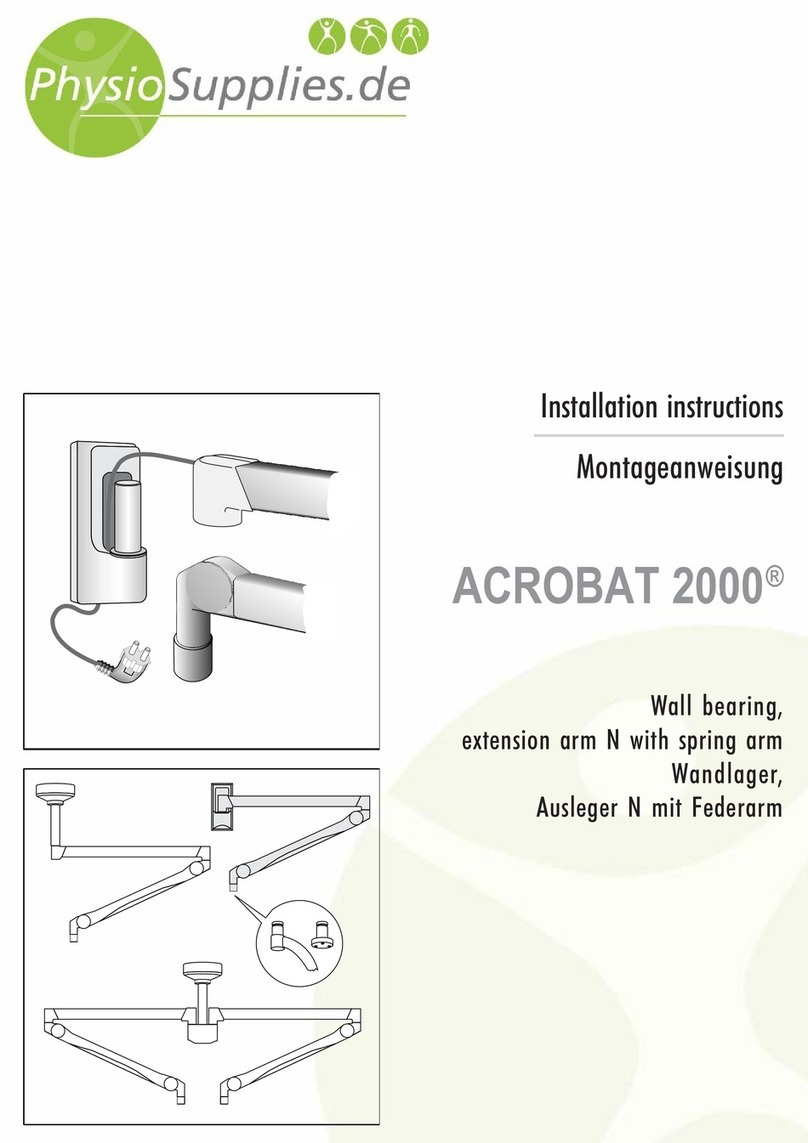
Ondal
Ondal ACROBAT 2000 installation instructions
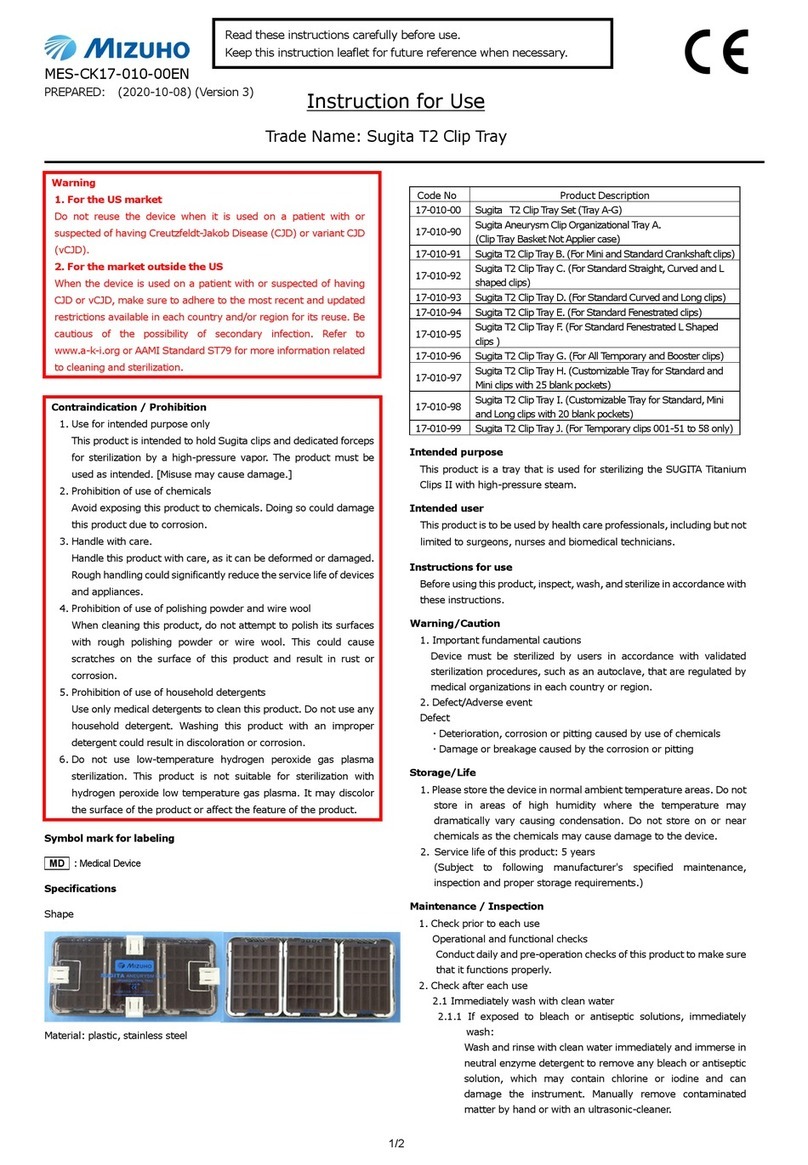
Mizuho
Mizuho Sugita T2 Clip Tray Series Instructions for use

bort medical
bort medical ActiveColor quick guide
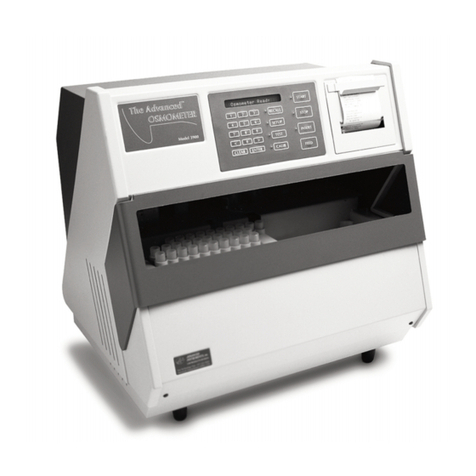
Advanced Instruments
Advanced Instruments 3900 Service manual
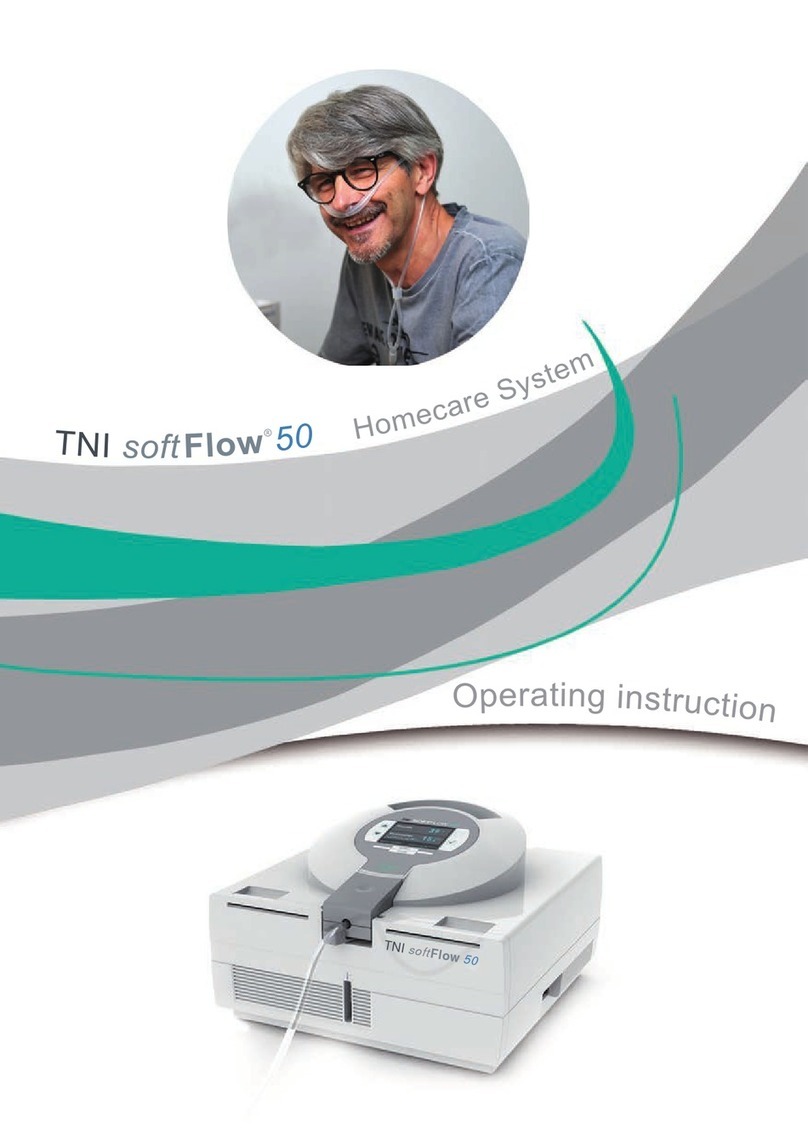
TNI
TNI softFlow 50 operating instructions
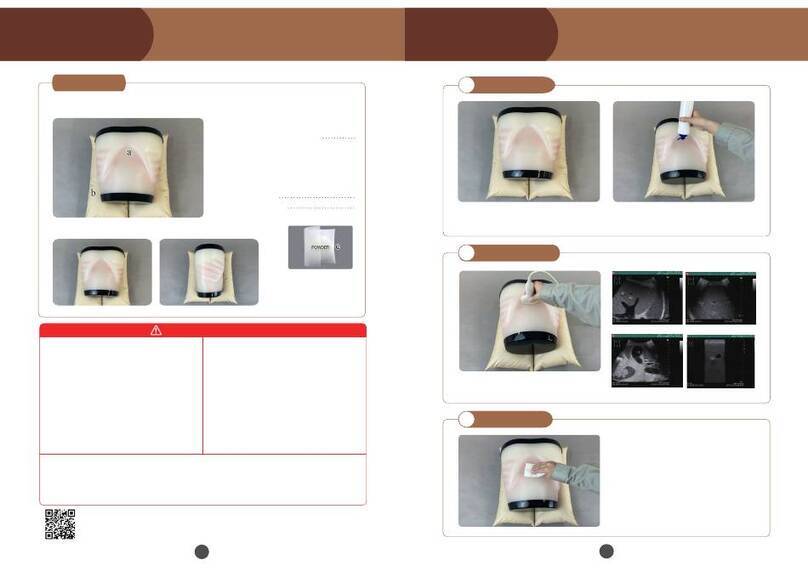
Kyoto Kagaku
Kyoto Kagaku US-22 instruction manual




